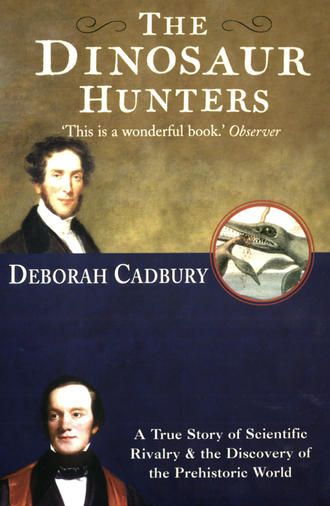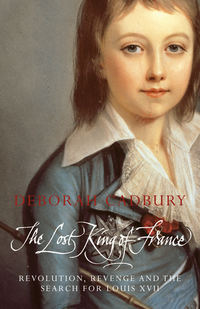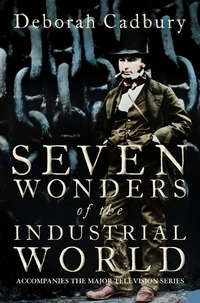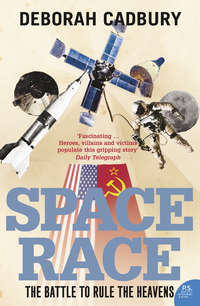
Полная версия
The Dinosaur Hunters: A True Story of Scientific Rivalry and the Discovery of the Prehistoric World
Other methods of dating the earth were occasionally put forward. In 1715, Edmond Halley had proposed an ingenious experiment to the Royal Society in which the rate of increase in the saltiness of lakes and oceans could be calculated, assuming that they contained no salt when the globe was created. However, his ideas were not pursued, and Halley himself thought his results were likely to confirm ‘the evidence of the Sacred Writ, [that] Mankind has dwelt about 6,000 Years’.
Apart from revealing the age of the earth, the Bible had other geological implications that were to prove equally challenging for the early geologists like William Buckland. The prophet Moses outlined the story of Creation in which God made the Heavens, the Earth and every living thing in just seven days. In the biblical Creation story all creatures were made simultaneously. There is no prehistory in the Bible, and no prehistoric animals.
Moses also described a universal Flood in which ‘all the fountains of the great deep and the windows of heaven were opened’, and the entire face of the earth was wiped out, destroying all creatures except the few saved in Noah’s Ark. Sacred texts were scrutinised so as to shed more light on these events. One highly respected seventeenth-century naturalist, a German Jesuit, Athanasius Kircher, produced a detailed paper on the dimensions of the Ark and its animal contents. This approach was still flourishing in 1815, when the Reverend Stephen Weston studied changing place-names in Hebrew and Greek and claimed to locate the very site where Noah’s Ark came to land – on one of the highest mountains of the earth in Tibet.
At Oxford, William Buckland knew that anomalies unearthed in the rocks during the eighteenth century had challenged religious scholarship. Many stones resembling creatures or plants had been uncovered in locations that defied explanation. How could it be that sea shells were found on the peaks of the highest mountains? Was this evidence for the Flood and, if so, how had such vast amounts of water been suddenly generated and then fallen away? Savants were hard-pressed to explain why stones that looked just like animal teeth were found deeply embedded in solid rock, or how plants had become petrified within layers of coal. If fossils were the remains of animals, why were bones of tropical animals found in cold northern regions? Had the climate been mysteriously inverted? Stranger still, why was it that fossils resembling fish buried in one rock could be covered by layers of rock that contained only land animals, and in turn have shells and sea plants in the rocks above? This seemed to provide evidence of astonishing disorder and devastation, which was hard to understand if the world was purposefully designed in seven days by the Almighty Creator.
By the late eighteenth century scholars were making progress in understanding the history of the earth, not by taking the Bible as evidence, but the rocks themselves. One of the spurs for this was the growth of the mining industry in parts of Northern Europe such as Thuringia and Saxony. It was here on the present border between Germany and Poland that a pioneering thinker, Abraham Werner, created an order out of the seemingly haphazard formation of rocks beneath the earth’s surface.
Abraham Werner was taken out of school at Bunzlau when his mother died, and sent to work for his father who managed the local ironworks for the Duke of Solm. He later entered the great Mining Academy of Freiberg, where his teaching on mineralogy became famous throughout Europe. Werner’s ideas and others’ showed that the earth’s crust could be classified into four distinct categories of rock, which were always found to be in the same order of succession. The oldest of these were the crystalline rocks such as granite, gneiss and schist, containing no fossils. These became known as the Primary rocks, corresponding to the most primitive period of the earth’s history, since these rocks were laid down first in the earth’s crust. Above these in order of succession were the Transition rocks, including greywackes, slates and limestone. Only a small number of fossils could be found here. This was followed by the Secondary period, with highly stratified rocks, sandstones, limestones, gypsum and many other layers, filled with fossils. Finally, the most recent were the generally unconsolidated deposits of gravels, sand and clays, corresponding to the Tertiary period.
Rather than accepting that the earth’s crust had formed in a mere six thousand years, Abraham Werner speculated that the older Primary and Transition rocks had formed more than a million years ago, by precipitation from a universal ocean that once enveloped the whole world. His theory implied that the order of rocks he had identified in Saxony would be found elsewhere. If his observations were right, the consequences of his findings were huge, as they were proof that locked within the earth’s crust was evidence of distinct periods in its formation. By identifying an order in the layers of rock, Werner was offering the world a glimpse of prehistory.
Even more perplexing amid the lecture-rooms of deans and bishops at Oxford was a new theory put forward by a Scotsman, James Hutton. He did not accept Werner’s view that the older rocks had precipitated from a universal ocean, but envisaged that they were formed gradually by erosion and deposition. This led him to speculate that the history of the earth was so vast it was almost immeasurable.
From his observations Hutton inferred that the earth was caught in an endless cycle of forming and re-forming the landscape: cycles in which rivers carried sediment from the land to the sea; layers of sediment gently accumulated and compacted into stone on the sea floor, until earth movements lifted the layers out of the sea, folding the different strata to form a new landscape. Since, he reasoned, the erosion of land and the accumulation of sediment take millions of years, the only conclusion was that the landscape had formed over millennia. In his book, Theory of the Earth, he wrote of the earth’s history, ‘there is no vestige of a beginning and no prospect of an end’.
The ideas of Hutton, Werner and others opened the door to an unfamiliar landscape as well as a vast, unknown history of the earth. This abyss of geological time was almost as strangely unbelievable as the vastness of stellar space opened up by Copernicus in astronomy two centuries earlier. The new theories questioned the long-established chronology for the earth’s age of Archbishop Ussher, and with it, the authority of the Bible. Many thinkers felt that this was a dangerous pursuit. Richard Kirwan, President of the Royal Academy in Ireland, was one of several leading thinkers to ridicule Hutton’s claims, pointing out that this was ‘fatal’ to the account in Moses and therefore a threat to morality. Hutton’s theory was so obviously flawed that Kirwan had found it quite unnecessary to even read it!
William Buckland, brought up in the heart of the Anglican establishment but drawn to a rigorous, scientific approach to gathering evidence, was eager to understand the true history of the globe within which fossils could be correctly understood. Wishing to reconcile the two seemingly opposing sides of his nature, he dedicated himself to proving that religion and science did not stand opposed to each other, but were complementary. For him, geology was a ‘master science’ through which he could investigate the signature of God.
In 1813, when Buckland was appointed Reader in Mineralogy at Oxford, such was his enthusiasm to make sense of the apparently conflicting opinions about the earth’s history that he embarked on a detailed study of all the rocks of England, travelling with his friend, George Bellas Greenough. Greenough had helped to found the Geological Society of London in 1807. This began as a ‘little talking Geological Dinner Club’ in a central London tavern, and had rapidly blossomed into a scientific society which aimed to ‘make geologists acquainted with each other, stimulate their zeal … and contribute to the advance of Geological Science’.
Touring with Greenough, Buckland aimed to construct a geological map for the Society of all the strata they could identify, showing the different layers of rock in each region and comparing the fossils within them. Would the layers of rock in England correspond to those in the European rocks? What did the different formations reveal about prehistory?
With infectious enthusiasm, Buckland also enlisted the support of his long-standing friend, the intellectual Reverend William Conybeare, who had graduated from Oxford just before Buckland, taking a first in classics at Christ Church with effortless ease. The unconventional party also called upon ‘the zealous interest of some ladies of high culture at Penrice Castle, Lady Mary Cole and the Misses Talbots’, and any other like-minded individuals they met along the way. Buckland’s energetic and novel approach, which would not be constrained by centuries of Oxford tradition, was viewed with more than a little suspicion.
Whereas most gentlemen’s travelling carriages would have been of a certain standard, with an elegantly appointed interior matched, perhaps, by a smartly painted exterior and with discreet uniformed staff in attendance, William Buckland’s carriage provided a very different travelling experience. The sturdy frame was specially strengthened to allow for heavy loads of rocks; the front was fitted with a furnace and implements for assays and analysis of the mineral content of the stone; and there was scarcely room to sit amid the curiosities and fossils heaped into every available space.
Gossip abounded, too, about Buckland’s other little eccentricities. It was the custom for early geologists to carry out their fieldwork in the full splendour of a gentleman’s suit, with academic robes and even a top-hat. When travelling in the mail, Buckland was not beyond dropping his hat and handkerchief in the road to stop the coach if he spotted an interesting rock. On one occasion he happened to fall asleep on the top of the coach. An old woman, eyeing his bulging pockets with growing interest, eventually couldn’t resist emptying them, only to find to her astonishment that the gentleman, for all his finery, had pockets full of nothing but stones.
Sometimes Buckland rode a favourite old black mare, usually burdened with heavy bags and hammers. It was said that the mare was so accustomed to her master’s ways that even if a stranger was riding her, she would stop at every quarry and nothing would persuade her to advance until her rider had dismounted and pretended to examine the surrounding stones. Buckland became so expert on the rocks of England that his ‘geological nose’ could even tell him his precise locality. Once, when riding to London with a colleague on a very dark night, they lost their way. To his friend’s astonishment Buckland dismounted and, grabbing a handful of soil, smelled it and declared, ‘Ah Uxbridge!’
William Conybeare, it seems, was as zealous in his search for fossils as Buckland, and their activities never failed to attract attention. Once on a tour together they entered an inn after a particularly long, wet day on the cliffs, covered in mud and dirt. The two deans had fossil bags filled to bursting and proceeded to empty out the contents. The old woman serving their meal was said to be ‘much puzzled to make out the Deans’ real character’. After eyeing her ravenous customers suspiciously, she exclaimed, ‘Well I never. Fancy two real gentlemen picking up stones! What won’t men do for money!’
In trying to create a map showing the order of succession of the rock strata of England, Buckland and his friends were greatly influenced by the pioneering work of a surveyor called William Smith. A man of humble birth, Smith lived at the height of the ‘Canal Age’ in the late eighteenth century, when the fields of England were criss-crossed by a network of over two thousand miles of inland waterways. As he surveyed the land for canal building, he had become very familiar with the sequential order of British rock from the chalk down to the coal. He noticed that different strata contained different fossils and that this could be used to help identify some of the layers. Such was his enthusiasm to understand the order of strata that Smith devoted his modest income to travelling all over England. Versions of his geological tables had been on display since the 1790s, and he published his great map A Delineation of the Strata of England and Wales in 1815.
Unfortunately for Smith, George Bellas Greenough, the first President of the Geological Society, had little time for him and his map. When he saw Smith’s tables he was condescending and patronising and yet, it has been argued, with ‘barefaced piracy’ he was able to draw heavily on this work for the benefit of the Society. Undoubtedly Smith’s studies laid the groundwork for Buckland, who between 1814 and 1821 produced no less than eight different charts of the ‘Order of super-imposition of strata in the British Islands’.
All of this made little impression on the canons and bishops at Oxford. Scholars and religious leaders were alarmed that the sacred evidence of the word of God should be muddied with bits of rock and dirt. ‘Was ever the Word of God, laid so deplorably prostrate at the feet of an infant and precocious science!’ exclaimed George Bugg, author of Scriptural Geology. ‘We want no better guide than Moses,’ wrote George Cumberland to the editor of the popular Monthly Magazine in 1815. ‘If the object of geology be to attain the age of the earth as a planet, it seems an idle proceeding; first because if attained, it would apparently be useless … it can never be attained by the present mode of enquiry; and like the riddle of the Sphinx, would destroy the life of those who failed in solving it, by wearing out the only valuable property they have, viz, their intellects!’
For years, dons wielding authority through their sermons and sacred texts had successfully kept alternative schools of thought at bay. Among the more traditional scholars there was a real fear that geology would prove to be a ‘dangerous innovation’, and Buckland’s odd activities were watched ‘with an interest not wholly devoid of fear’. At the end of the Napoleonic Wars in 1816, when Buckland took the opportunity to travel with Conybeare and Greenough across Europe, his departure was welcomed by some of the elderly classicists at Oxford. ‘Well Buckland has gone,’ announced one dean with satisfaction. ‘Thank God we will hear no more of this Geology!’ Nothing could have been further from the truth.
In 1816, Buckland published the first comparative table of the strata of England compared with those of the Continent. Similarities between the rocks of England and Europe were beginning to emerge. Greywacke slates, resembling the continental Transition formations, were found on the borders of England and Wales. Highly stratified layers of sandstone, limestone and conglomerates rich with fossils, like the Secondary formations of Europe, were widespread across England. Tertiary rocks, such as those around Paris, were identified in the London and Hampshire basins. Just as in Europe, these were always in the same order of succession, the oldest being Primary, then Transition, Secondary and Tertiary. As correlations were found between different regions, ‘marker’ rocks were identified. Chalk, for instance, was recognised as the upper limit of Secondary rock throughout Europe.
Buckland was keen to discover whether this order of succession extended worldwide. He wrote to several noblemen in command of Britain’s growing Empire, such as Lord Bathurst, the Secretary of the British Colonies, enclosing instructions for collecting geological specimens abroad. His appetite for information became insatiable: it was as if the layers of rock that enveloped the globe formed the pages of a history of the earth. But if this was so, what would be written on them? And how did all this fit with the extraordinary ‘crocodile’ found by Mary Anning?
The first clue to this puzzle lay in a remarkable new approach to interpreting fossils that was being pioneered in Paris by a French naturalist called Georges Cuvier. From a poor but bourgeois family, Cuvier had survived the French Revolution in Normandy, far from the troubles of Paris, where in his letters he had feigned support for the regime for fear of the French police. Once the Reign of Terror had released its grip on Paris and the city became safe again, Cuvier went to the capital and soon secured a post at the Muséum National d’Histoire Naturelle. With his striking crop of red hair, bright-blue eyes and somewhat unkempt appearance, it wasn’t long before the ambitious young naturalist had made an impression.
As Napoleon’s army swept across Europe, spoils from museums and private collections were frequently sent back to Paris. Fossils were also retrieved from the plaster quarries around Paris, and during the course of building canals around the city. The new Muséum National d’Histoire Naturelle, established by the Republicans in place of the Jardin du Roi, rapidly became the envy of the world. Cuvier began to apply his extensive knowledge of the anatomy of living creatures to try to interpret fossil skeletons with a view to understanding the ancient forms of life.
Georges Cuvier believed that fundamental laws must govern the anatomy of creatures as surely as the laws established by Newton now governed physics. If a creature was a carnivore, Cuvier observed, all of its organs would be designed for this purpose. The forelimbs would be strong enough to grasp prey; the hind-limbs muscular and mobile, for hunting; the teeth would be sharp, capable of ripping meat; the jaw would have sufficient muscular support for the animal to tear prey; and the digestive organs would be adapted for carnivorous food. In effect, Cuvier’s principle of ‘correlation of parts’ showed that all the organs and limbs of a creature are interdependent and must function together for that creature to survive. He rapidly acquired a brilliant reputation. From a single fossil bone, he declared, he could deduce the class of the beast – whether it was a mammal, reptile or bird – and ascertain subordinate divisions: the order, family, genus (plural: genera), and perhaps even the very species to which the fossil animal belonged.
‘Let us not search further for the mythological animals,’ said Cuvier. ‘The mantichore or destroyer of men which carries a human head on a lion’s body terminating in a scorpion’s tail, or the guardian of treasures, the Griffin, half eagle–half lion … Nature could not combine such impossible features.’ The teeth and jaws of a lion, for example, could only belong to a creature that possessed the other attributes of a powerful carnivore, a muscular frame and skeleton that would confer enormous strength. The Sphinx of Thebes, the Pegasus of Thessaly, the Minotaur of Crete, mermaids – those half-women half-fish that lured sailors to their death with the sweetness of their song – were all myths that crumbled under Cuvier’s scientific scrutiny. ‘These fantastic compositions may be recovered among ruins,’ he said, ‘but they certainly do not represent real beings.’ Instead, Georges Cuvier offered a real past, conjuring up a vivid picture of creatures that had once roamed the surface of the earth.
Less than two years after his arrival in Paris, in January 1796, the twenty-seven-year-old naturalist made his debut at the National Institute of Sciences and Arts. His talk ‘On the species of living and fossil elephants’ pointed to an astonishing conclusion.
Following French victories in Holland, a private collection of fossil ‘elephants’ at the Hague had been seized and sent to Paris. Cuvier had compared these fossils from Holland to the bones of present-day elephants from India and Africa. As he studied the characteristics of the teeth and jaw he realised that the fossil ‘elephant’ differed in the shape and proportions of the jaw from either of the two living species. On the basis of these differences, he argued, the fossil ‘elephant’ should be classified as a separate species. The distribution of the fossil bones also differed; unlike the Indian or African elephant, the fossil species was never found in the tropics. He gave the fossil elephant a special name in recognition of its differences: the ‘mammoth’.
Since mammoths differed from any living elephants, reasoned Cuvier, this species was now extinct. The discovery, soon after this, of the first preserved mammoth in the permafrost of Siberia lent weight to his ideas. Cuvier believed the snowy wastes of Northern Europe and Siberia had once been inhabited by these enormous woolly beasts, which had somehow mysteriously perished. And he went on to show that other large fossil mammals, apart from the mammoth, had thrived on the ancient globe. He identified ‘Megatherium’, or ‘huge beast’, a creature resembling a giant sloth and covered in fur like a bear, which could stand on two legs to graze on leaves. An elephantine creature whose fossils combined the teeth of a hippopotamus with the huge tusks of a mammoth was named by Cuvier a ‘mastodon’.
Cuvier’s large extinct mammals, the mammoth, the mastodon and Megatherium, were found in the most recent, Tertiary deposits. In older strata Cuvier identified an ancient sea lizard, ‘Mosasaurus’ or ‘lizard of the Meuse’, and several extinct species of crocodile. His studies suggested that entire animal races had been wiped from the face of the earth. He was haunted by the desire to know what had happened to the vanished creatures. Why would God create these beings if He planned only to destroy them? Cuvier wanted to ascertain whether ‘species which existed then have been entirely destroyed, or if they have merely been modified in their form, or if they have simply been transported from one climate into another’. Quite why and how extinction occurred was a puzzle that remained to be solved.
William Buckland was impressed by Cuvier’s discoveries and eager to learn from his approach, comparing fossil animals to living creatures so as to work out their zoological affinities. He discussed Mary Anning’s unknown creature with his friend the Reverend Conybeare, who wanted to make a definitive scientific study of the giant beast. Mary’s ‘crocodile’ possessed such a puzzling blend of characteristics that it was hard to classify. The long, pointed snout was similar to a dolphin’s or porpoise’s. The teeth were more like those of a crocodile, with sharp, conical fangs, each one ridged all around the enamel. The vertebrae were slender, like the backbone of a fish. It was baffling.
To compound their problems, England did not have a centre of anatomical excellence comparable to the magnificent collections under Cuvier’s supervision in Paris. Consequently, Buckland tried to establish a correspondence with Cuvier, ‘founded on an exchange of fossil specimens’, and hoped to benefit from the French expertise.
It was to Lyme that the Reverends Buckland and Conybeare went in search of fossil ‘crocodiles’ as gifts for Cuvier, and in particular to the collection of Mary Anning.
Mary and her mother had established a ‘tiny, old curiosity shop close to the beach’. According to one visitor, ‘the most remarkable petrifactions and fossil remains … were exhibited in the window’. Inside, the little shop and adjoining chamber were ‘crammed with ammonites, heads of “crocodiles”, and boxes of shells’. To Mary’s skills as a collector, Buckland acknowledged, he felt greatly indebted, for she continued to supply more specimens of her unknown creature. Cuvier was interested to see the latest discoveries from England, and soon Buckland established a correspondence with a young assistant in Cuvier’s department, Joseph Pentland. Pentland acted as liaison between Cuvier and the English team, organising shipments of casts and providing information on fossils.
But while Buckland and his colleagues were approaching Georges Cuvier, another London gentleman, Sir Everard Home, raced into print with the first published account of Mary’s creature. Although Sir Everard relished his reputation as Britain’s leading anatomist and held the distinguished position of Surgeon to the King, he was in fact not only incompetent, but also a fraud. Much of his fame was due to reflected glory from John Hunter, his famous brother-in-law.








